FRED VAN LENTE pits the Silver Age freaks against the Silver Age freaks…
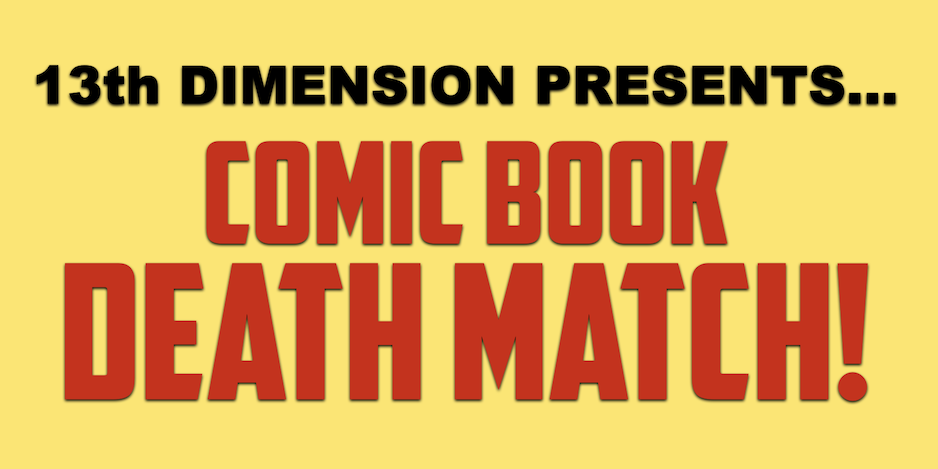
Hey, it’s a new installment of Fred Van Lente’s COMIC BOOK DEATH MATCH, in which our fearless columnist takes two related-but-opposing titles, chooses a bunch of issues covering several years, reviews them, and then, using a completely infallible set of criteria, decides which is better.
It’s your foolproof way of ending any and all such comics arguments — a service from 13th Dimension!
This time around it’s Silver Age Doom Patrol vs. Silver Age X-Men, seeing as how the new season of HBO Max’s Doom Patrol is upon us.
So let’s have at it!
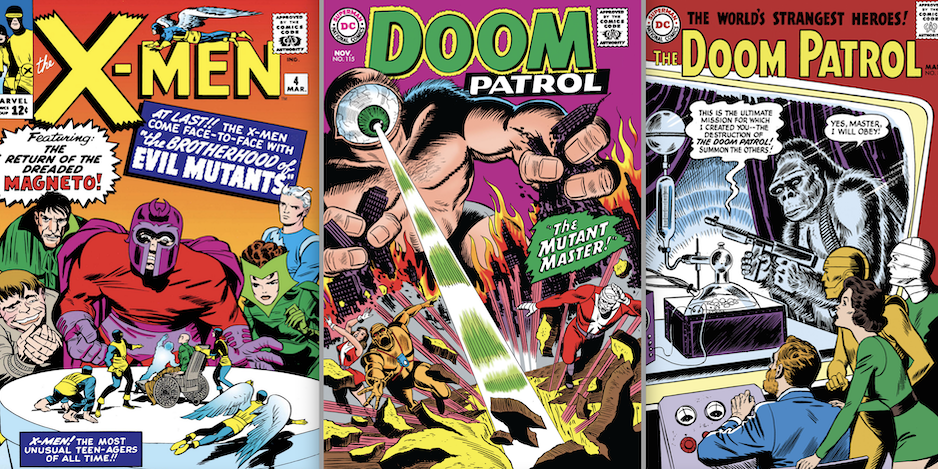
By FRED VAN LENTE
Let’s get ready to reeeeeeead cooooooooomics!
Greetings, Retrofolk, and welcome to another thrilling installment of COMIC BOOK DEATH MATCH, where we pit two contemporaneous runs of semi-related titles against each other and determine which one is better under a totally arbitrary criteria determined by me, because it was my idea, tough.
I am going to make the bold statement that My Greatest Adventure #80, featuring the first appearance of the Doom Patrol by writer Arnold Drake and artist Bruno Premiani, is up there with, say, Amazing Fantasy #15 as one of the greatest origin stories of all time. We are deftly introduced to Rita (Elasti-Girl) Farr, Larry (Negative Man) Trainor and Cliff (Robotman) Steele; the accidents that turned them into superpowered freaks; and the mysterious, wheelchair-bound Chief, who brings them together and inspires them to win back society’s approval by fighting on their behalf. They then immediately launch into a race with a great, memorable villain, General Immortus, to salvage an alien spaceship.
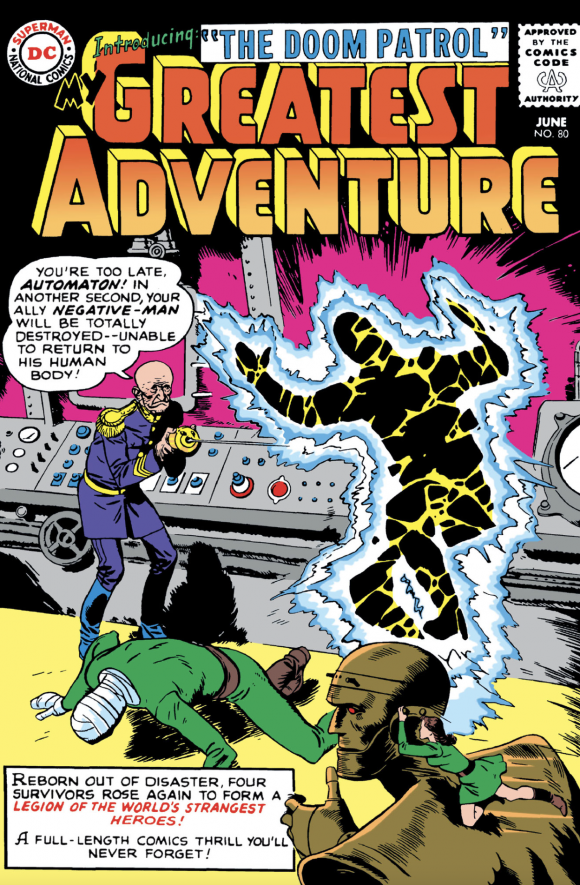
It’s a deft 25-page classic done-in-one that could really use, I dunno, a remake as a prestige Black Label series (DC, you know where to find me).
As it turns out, series co-creator Drake was really impressed by what those Marvel guys were doing across town and, when asked to create a regular feature for My Greatest Adventure, decided to try a strip in the style of the House of Ideas. With the constant interfamilial bickering of its hero quartet and epic storylines, Doom Patrol resembles nothing less than a weirder version of Marvel flagship Fantastic Four.
But it would appear that Marvel knows how to read other people’s comics too, because just a few months later, it debuted its own team of superpowered misfits lead by a wheelchair-bound genius originally called The Mutants until company owner Martin Goodman complained that no kid knows what the heck a mutant is.
Oh, but they learned! They learned!
Which feature is better – Doom Patrol or X-Men? I’ll be the judge!
—
JULY 1963
My Greatest Adventure #82: “Three Against the Earth!”
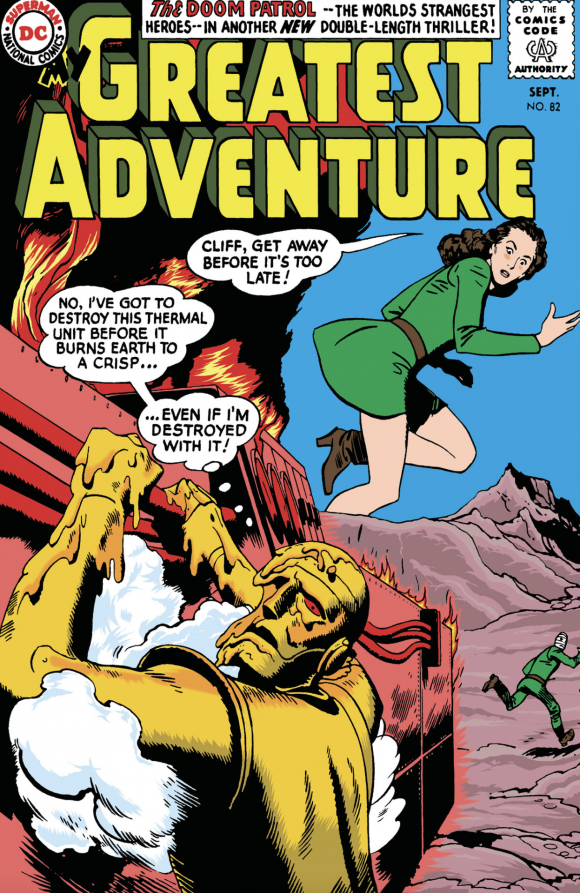
The Chief reveals his up-to-now-unknown origin to the press—he’s actually an alien posing as a human using his extraterrestrial genius to help us pathetic Earthlings.
Spoiler alert: These are lies.
He’s tricking the actual aliens posing as humans to reveal themselves to come after him so the Doom Patrol can defeat them. If you think that makes no sense, I am not going to argue with you. But the aliens have cool weird gadgets and it’s fun to watch the Patrol tangle with them.
—
The X-Men #1: “X-Men”
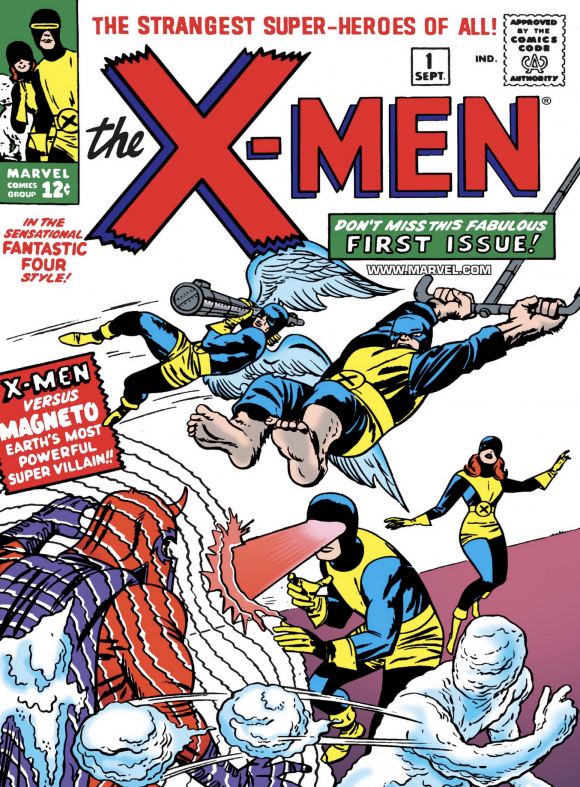
Other than their wheelchair-bound leader, the X-ers don’t have a whole lot in common with the DP-ers at first glance. The first half of the issue introduces the brilliant concept of the Danger Room, which gives storytellers an excuse for gratuitous action shots that introduce Professor X’s boys and their powers at a drop of a hat.
And I do mean “boys,” because the next thing that happens is that Xavier School goes co-ed with new student Jean Grey (Marvel Girl, the female equivalent of “Mr. Fantastic” of unimaginative Marvel hero names), whom Scott (Cyclops), Hank (Beast), Bobby (Iceman) and Warren (Angel) promptly drool over. Professor X explains to Jean that the purpose of his school—and its militant wing, the X-Men—is the same as the Chief’s Doom Patrol: Public relations. #MutantRepresentationMatters, and the X-ers are out to prove that mutants aren’t as scary as normies fear.

Magneto, of course, then shows up with the exact opposite program and takes over a US Army missile base. Like any responsible adult, Xavier sics his as-yet untested students on this maniac. That’s why your parents signed those waivers in your enrollment packets, kids. Extra credit in Civics if nuclear war is avoided!
The ensuing battle is as rushed and cramped as the infamous panel of Magneto almost completely covered by his own rant-filled word balloon—and a tight close-up of the Master of Magnetism on this same page that Roy Lichtenstein would swipe later this same year for one of his most famous paintings. That said, introducing several genre-shaking Big Concepts and eight major characters in 23 pages of comic is no mean feat.
WINNER: X-MEN
—
JANUARY 1964
Doom Patrol #86: “The Brotherhood of Evil”
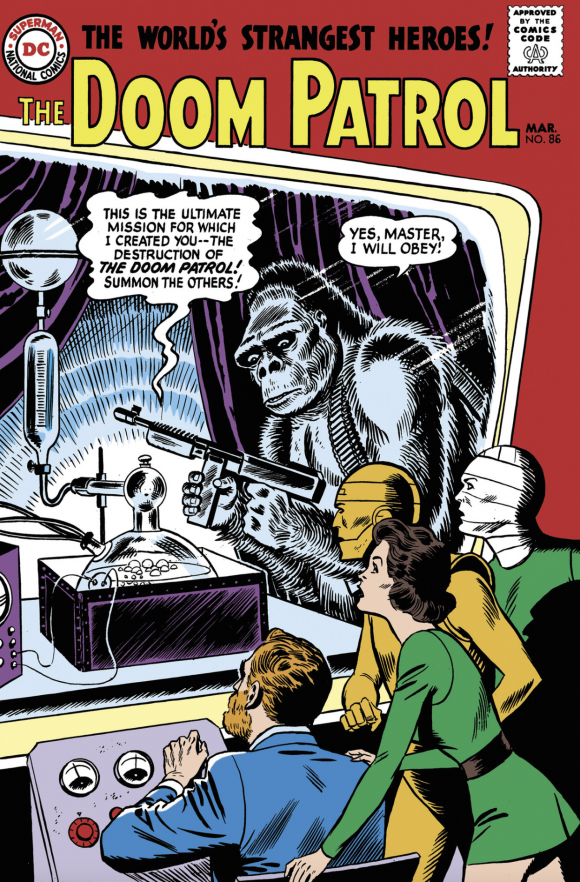
The title of My Greatest Adventure, but not its numbering, changes to that of its lead feature, and just in time for the Patrol’s biggest enemies to be introduced. The issue opens with our heroes collecting various gifts for what they have arbitrarily decided is the mysterious Chief’s birthday (of course, we later learn they have accidentally chosen to do so on his actual birthday).
Then they immediately have to thwart Mr. Morden, the future Mr. Nobody, from committing crimes with a giant Chief-designed robot. This turns out to be an initiation into the Brotherhood of Evil, the only criminal cartel in history run by a French schoolmarm, a French brain in a jar, and a French talking gorilla. No wonder they want Morden to steal the French-built Statue of Liberty back, which the Doom Patrol thwarts in one of the best fights of the series.
Boy oh boy, I don’t know how the X-Men can top this awesomeness, it’s not like they have their own Evil Brotherhood waiting in the wings to take on our—
—
The X-Men #4: “The Brotherhood of Evil Mutants!”
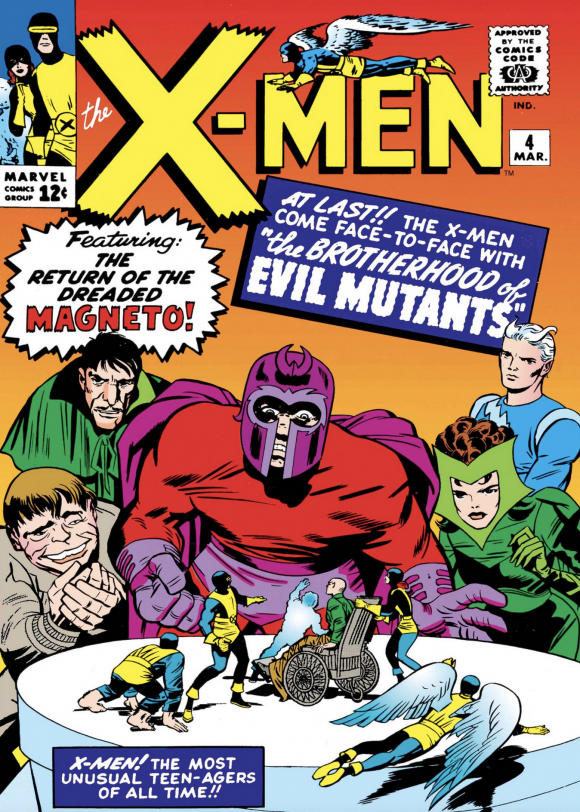
Wait, WHAAAAAAT? Both Brotherhoods premiered in the same month?! The opening scene here also involves a birthday (Prof. Xavier’s class’ first year together), with cake, which is equally weird. I can sense Arnold Drake’s eyebrow starting to twitch as these “coincidences” mount.
Like the X-Men, we are introduced to this Brotherhood with some light sexual harassment: Mastermind macks on Scarlet Witch and Quicksilver tries to beat the crap out of him. In their very first outing, Wanda and Pietro try to flee the group, but Magneto guilts them into staying by reminding them how he rescued them from a torch-wielding mob who dubbed Wanda a “Scarlet Witch.”
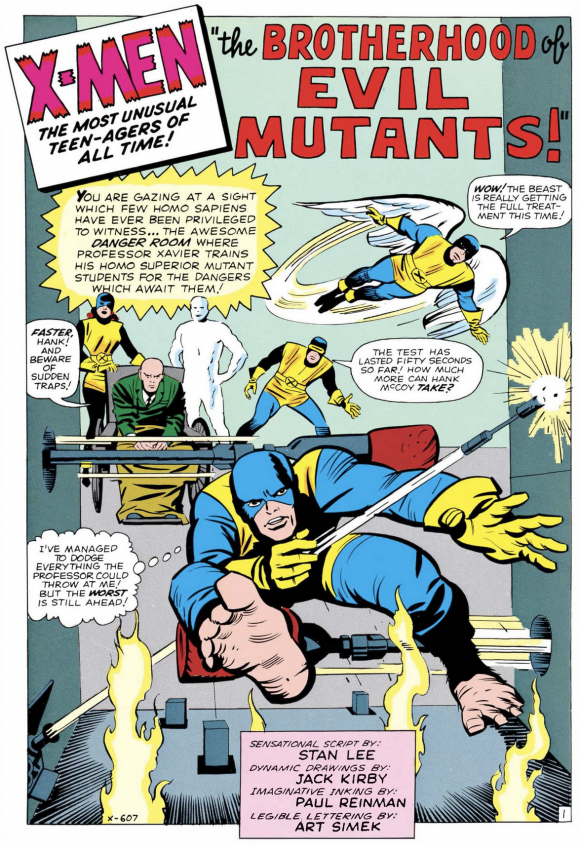
Other notable firsts in this issue include Professor X telepathically contacting Magneto to try and talk him out of being evil, which is about as successful as you might expect, but also sets up their relationship as more intimate than your typical good guy/arch-nemesis dynamic.
Magneto and his four underlings knock over a small South American dictatorship in an afternoon to make homo sapiens poop their collective pants. The X-Men show up for a counter-revolution and have a pretty cool Jack Kirby-drawn throwdown with their evil counterparts. Professor X is knocked into a coma as the bad guys escape, establishing a long-running X-Men tradition of putting Xavier on the IL for enhanced feels.
WINNER: DOOM PATROL (by a hair)
—
APRIL-MAY-JUNE-JULY 1965
(Both these titles were on weird publishing schedules.)
Doom Patrol #96-97: “The Day the World Went Mad”/“The War Against the Mind Slaves”
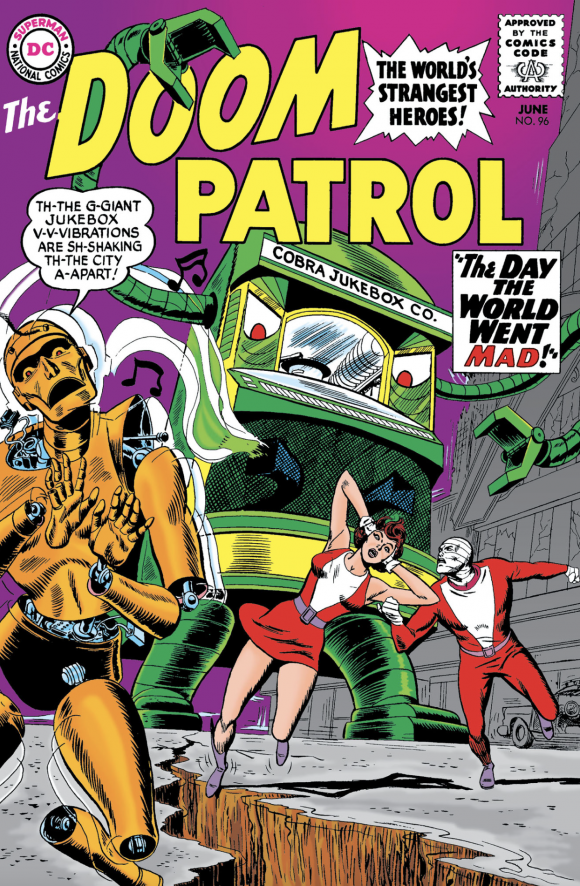
I wanted to point out that on #97 the cover proclaims that the DP is the “Original World’s Strangest Heroes,” which seems undoubtedly a dig at Xavier’s Kids. Apparently, Arnold Drake was sincerely annoyed at the X-Men and the Brotherhood of Evil Mutants, which he saw as rip-offs of his and Premiani’s ideas. Knowing what I know about the lead time required to make comics, I myself find that highly unlikely, and later in life (according to Wikipedia), Drake apparently reached the same conclusion.
I don’t know what Drake was so worried about, because DP’s adventures are truly sui generis. In this insane epic, the DP’s three major enemies (Garguax, Gen. Immortus, the Brotherhood of Evil Not-Mutants) unite to wreak havoc across the globe with a mind-control cannon from their moon base: a peace guru opens fire with a machine gun in the United Nations; a jukebox designer makes a giant kaiju-sized walking jukebox that attacks the city with sound waves that knock over bridges; and other totally plausible scenarios.
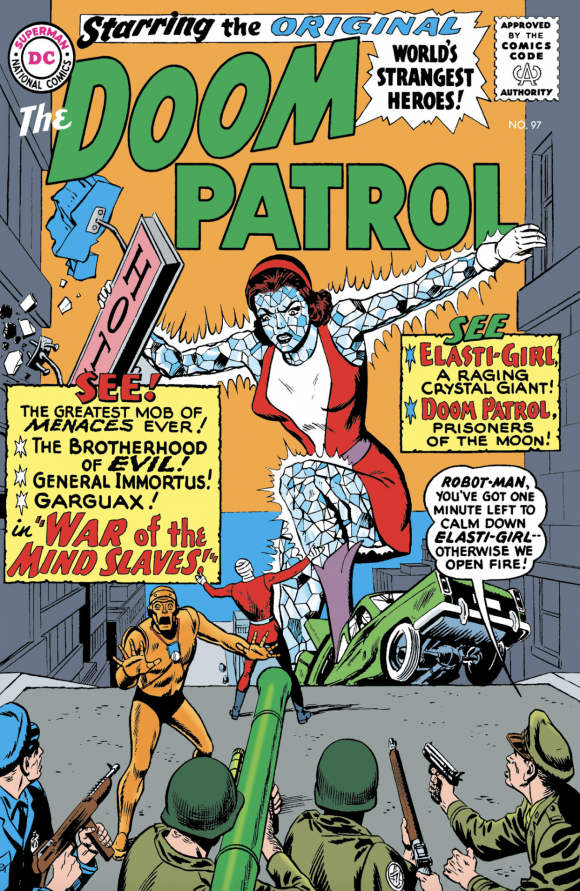
If you get exposed to the ray enough, you get turned into a giant crystal zombie, because, uh, why not? Diamond dogs attack China, Sweden (where Monsieur Mallah is undercover as a gorilla lumberjack for some reason) and Africa, the three most important places on Earth. Rita gets zapped by the ray and becomes an extra-huge crystal mind slave, so her psychic stalker Mento (the Fresh-Maker) comes in to help save the day. He gets voted down for official DP membership by Rita, who finds him a bit much (though she’d come around eventually).
—
The X-Men #12-13: “The Origin of Professor X!”/“Where Walks the Juggernaut!”
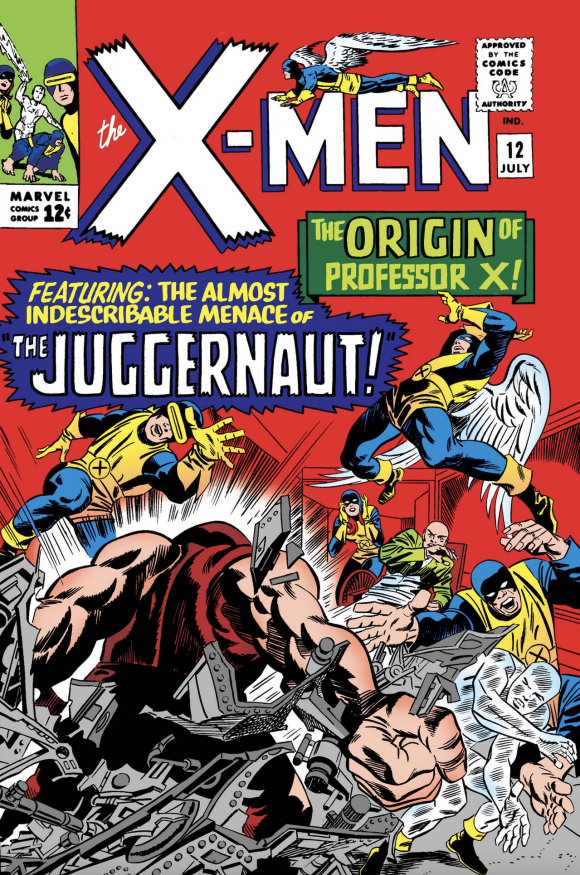
Like the Chief, Professor Xavier’s background has been shrouded in mystery; but here he tells his charges his Shakespearean backstory of an evil stepfather and eviller stepbrother, Cain Marko, as a mysterious threat advances on their mansion. The set-up is truly suspenseful and classic Kirby, but it is my sad duty to inform you that Part 1’s Dream Team of Alex Toth finishing Jack Kirby layouts, is… not great. Sounds amazing on paper, but this is why we play the games.
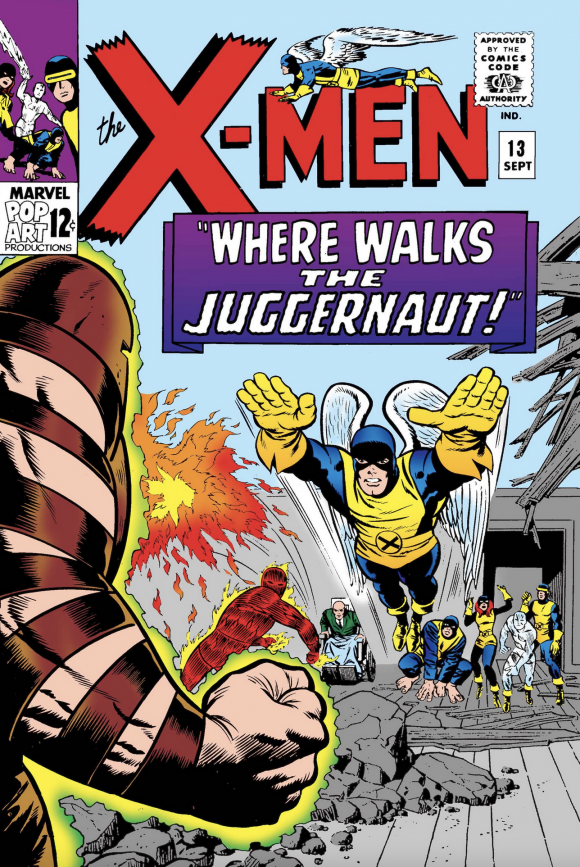
Part 2’s finishes are by Werner Roth, drawing under a pseudonym so DC wouldn’t know he was working for the competition. He actually fares better than Toth. It doesn’t help that Juggernaut’s original design makes him look like a man uncomfortably bursting out of a giant football. Cain Marko gets his powers from the extremely Kirby-esque source of wearing a gem on top of his head (sure, that’s a thing) and the X-Teens have to figure out how to stop the unstoppable. They succeed only after a great fight and Professor X telepathically recruiting the Human Torch.
There’s a lot to like here, but the weak art makes picking between this and DP a challenge. I almost prefer this story’s loose adaptation in one of the better episodes of Spider-Man and His Amazing Friends.
Still:
WINNER: X-MEN
—
SEPTEMBER 1967
Doom Patrol #115: “The Mutant Master!”
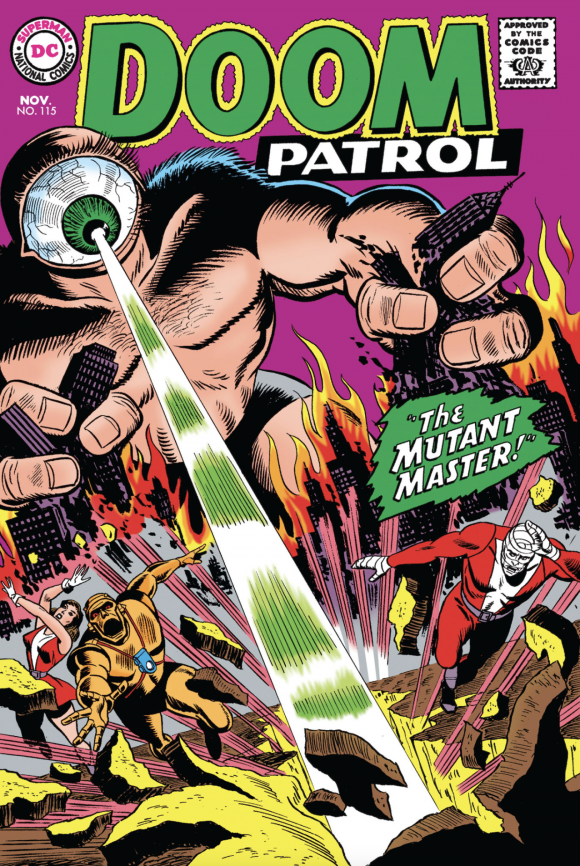
Arnold Drake’s annoyance at the existence of the X-Men clearly boils over here, with the enemies being, like the X-ers, radiation-enhanced mutants. But as you can see from the cover, none of DP’s mutants are going into the modeling game as Jean Grey is about to any time soon. More “realistic” deformities and weirdness from A-bomb exposure abound. These mutants so hate the humans that spawned them that they use their vast mental powers to bring a comet to Earth to destroy it. Rude!
One of the highlights of the title for the last year or so are the back-ups focusing on solo “origin” adventures of the main characters before they joined the team. In this issue, a crazy back-up features Beast Boy, the teen member I feel like was undoubtedly introduced to compete with X-Men, infiltrates a Nazi army of gorillas (as a giant green gorilla, natch) to stop them from conquering Africa, a continent under near-constant jeopardy in this series. Yes, it is totally insane, and totally wonderful.
—
The X-Men #38: “The Shimmering Shadow of… Doomsday!”
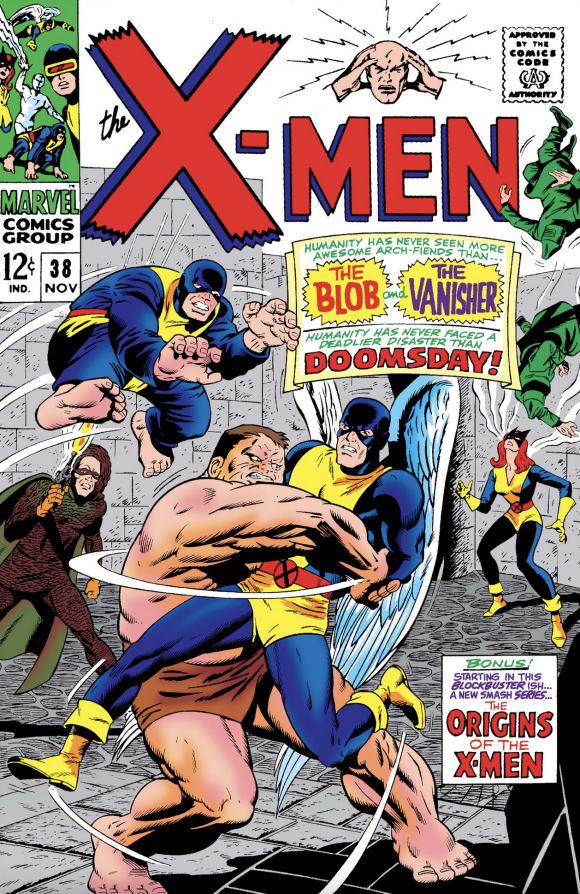
This is the second part of a story in which the X-Men fight a villain called… The Mutant-Master! [CUE SOUND OF ARNOLD DRAKE REPEATEDLY BASHING HIS HEAD AGAINST HIS DESK] Stan Lee and Jack Kirby are long gone, replaced by Stan’s assistant Roy Thomas and veteran utility man Don Heck. The improbably-headdressed Mutant-Master is the Moneyball of supervillains, gathering together previously unaffiliated X-Villains like Blob and the Vanisher to execute his bog-standard Cold War scheme of getting NATO and the Soviet Bloc to destroy each other in a nuclear war. Yawn.
The main story is only 15 story pages long. Beginning this issue is a series of… uh, origin stories of the various X-Men, this one featuring Professor X (written by Thomas, drawn by Roth) trying to track down Scott (Cyclops) Summers before an angry mob gets him first.
Wait a… what the hell? Doom Patrol has been doing the exact same thing for over a year now! SHOTS FIRED! Maybe The X-Men has devolved into an elaborate scheme to destroy Arnold Drake’s sanity!
WINNER: CONSPIRACY THEORISTS
—
JULY 1968
Doom Patrol #121: “The Death of the Doom Patrol?”
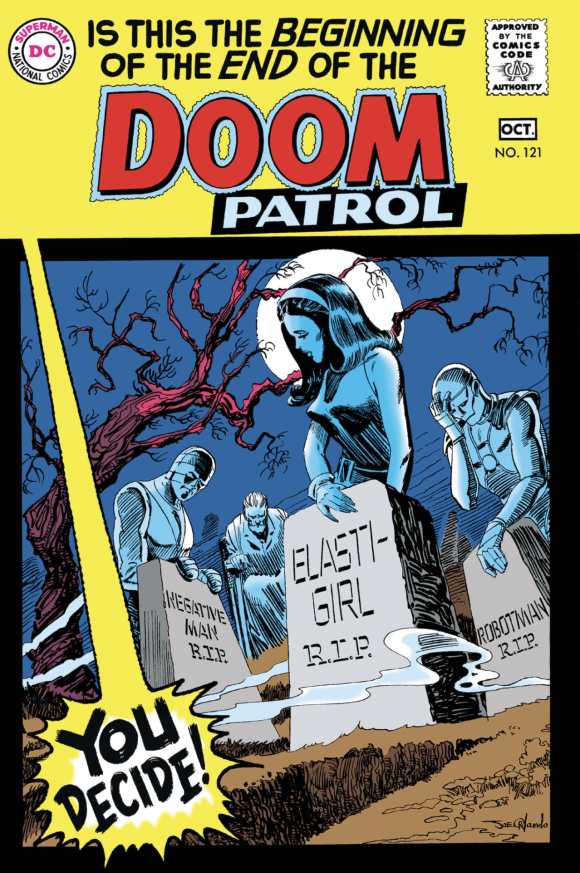
One of the stranger, long-running subplots of this book has been the tug of war for the soul of Madame Rouge, the rubbery shape-shifter of the Brotherhood of Evil. First, she fell in love with the Chief, and he beamed subliminal messages into her bedroom to turn her good while she sleeps.
As if that wasn’t sketchy enough, the Brain heard her talking in her sleep and started sending her subliminal messages to keep her evil. This, shockingly, drove her a little bananas, and after briefly joining the Doom Patrol and the Chief falling in love with her, Rouge goes Full Evil and decides to exact a terrible revenge on both groups for messing with her noodle.
I have to say I am kind of on her side at this point?
First, she blows up the Brotherhood of Evil HQ in (where else) Paris, killing Brain and Monsieur Mallah. Her relentless attacks on the DP forces the city to kick them out for public safety. The Chief, smarty-pants that he is, has outfitted an island fortress for just this occasion, which—oops!— Rouge has covered with explosives. Rouge and her ally in evil and terrible accents, General Zahl, have also booby-trapped a Maine fishing village. The DP has to choose whether to be humiliated as cowards or die as martyrs by choosing which island the baddies blow up. Guess which they choose?
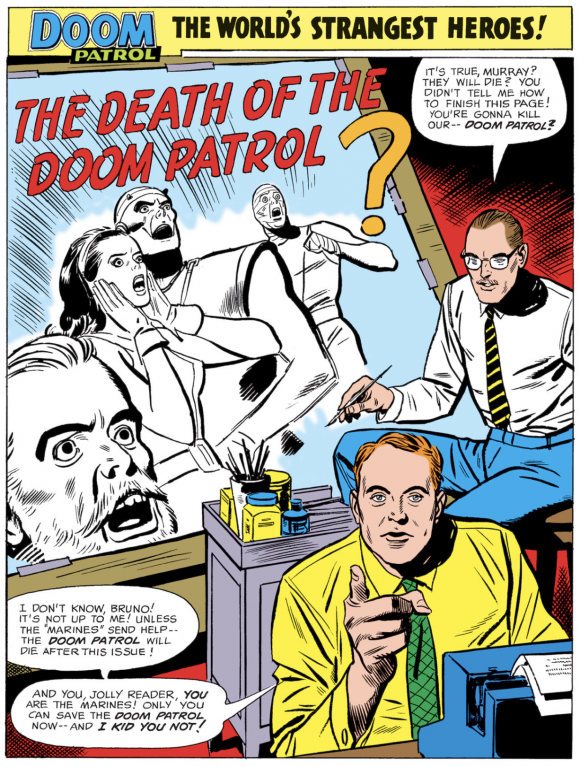
The story is framed by artist Bruno Premiani and editor Murray Boltinoff challenging the readers to write in with a way our heroes could have escaped this death trap. I guess Charlie Short-Pants’ pitch wasn’t enough to overcome flagging sales, because this is the last issue of this series—for now. Don’t worry, every single person, floating brain and gorilla killed in this story turns out to be comic book-dead and returns soon enough, and The New Teen Titans bring Rouge and Zahl to justice a decade and a half later.
But for some reason, co-creator and writer Arnold Drake is nowhere to be found with Premiani and Boltinoff in this framing device! Where is he? Where could he be?!? Arnold, yoo-hoo, where’d you go?
—
The X-Men #48: “Beware Computo, Commander of the Robot Hive!”
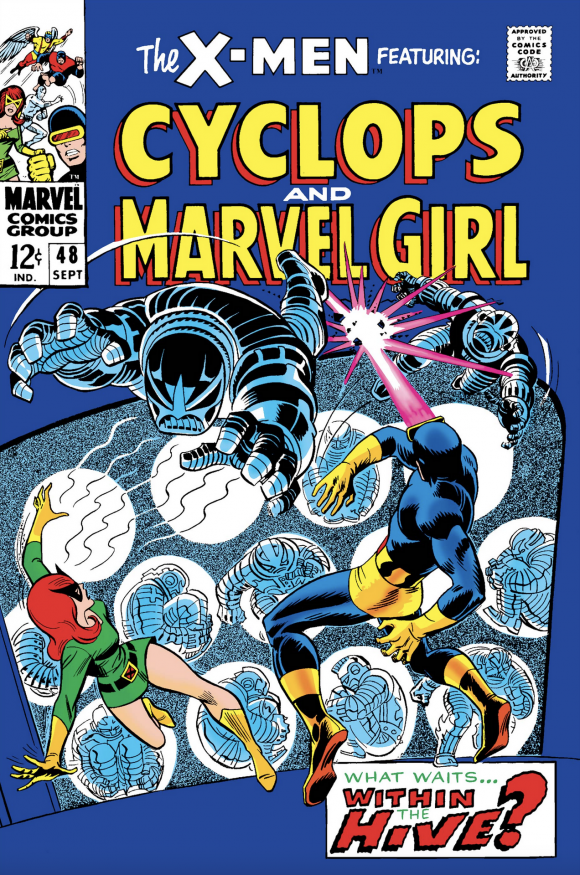
That cover is bananas. And the story is a breath of fresh air this title hasn’t experienced in some time. The X-Men have disbanded after Professor X has comic book-died again, and Jean Grey is pursuing her modeling career, an oddly ubiquitous profession in the Marvel Universe. Her boyfriend, Cyclops, has gotten a job as a radio reporter, so our hero couple hear first when some wacko sends his army of creatively designed androids out to attack the city. The art couple of Werner Roth and Don Heck is surprisingly effective, and the back-up is a delightful Roth-drawn solo visit with the Beast.
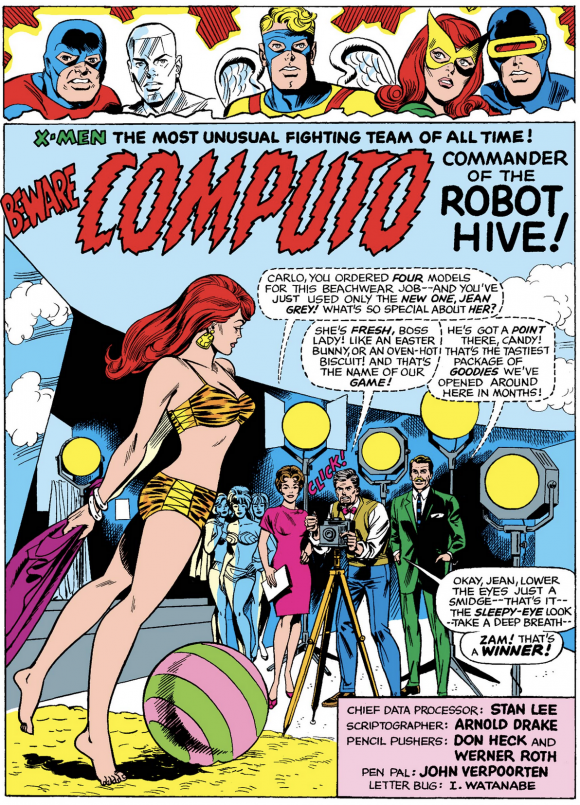
Though I am sorry to report that the copycat pattern continues. Computo reminds me a lot of Garguax, the rotund android-manufacturing alien foe of the Doom Patrol. This new writer, Arnold Drake, is just continuing the long tradition of ripping off Arnol…
Wait a minute. Arnold Drake is the new X-Men writer! In fact, he’d go on to co-create Polaris and some other memorable aspects of the X-Mythos.
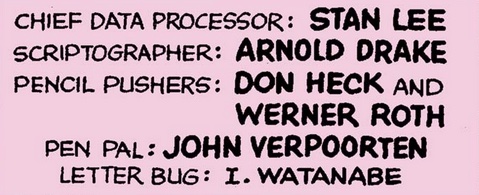
So that’s why he got spitefully shut out of appearing in the last issue of his most famous title—DC was peeved he defected to the House of Ideas, where he’d be best known for scripting Captain Marvel and creating the original Guardians of the Galaxy (a personal fave) with Gene Colan.
If you can’t beat ‘em, join ‘em.
WINNER: ARNOLD DRAKE
—
Who is the overall winner? Doom Patrol got cancelled first, so, in pure business terms, you’d clearly call it for the other side.
But after the departure of Kirby and Lee, X-Men gets handed over to a revolving door of neophytes and journeymen and limps along year after year with a lot of uninspired stories. I am a little perplexed why Marvel kept it going for so long. After all, they had no problem axing The Hulk after his first six issues.
While introducing a ton of cool concepts, from a superhero school, to the Danger Room, to the metaphor of mutants as second-hand citizens, to a next stage of human evolution struggling over our future, it’s not until the advent of Len Wein, Dave Cockrum, Chris Claremont and friends in the next decade that creators would figure out a way to make those elements really gel.
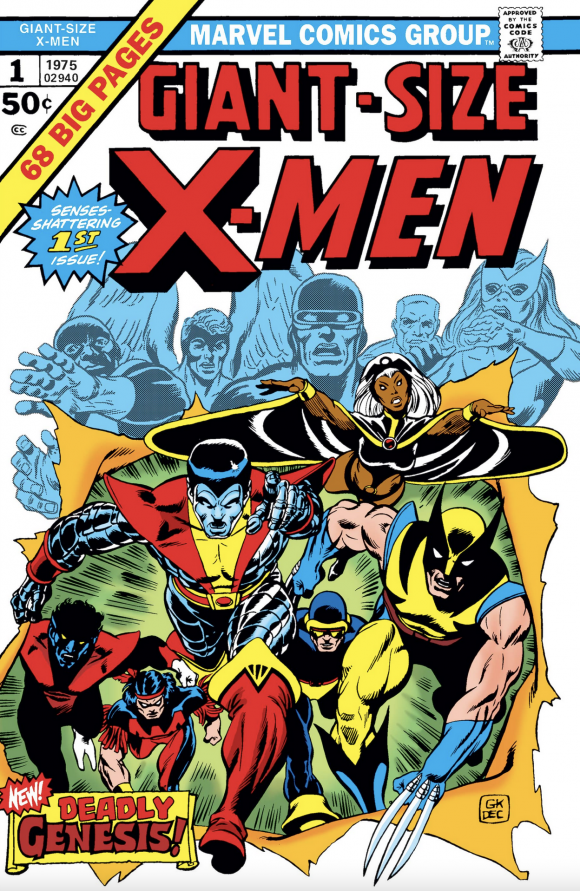
And even though Doom Patrol can go a little overboard with the wackiness for even my taste, it retains the same creative team throughout its run (high marks from me), its characters are terrific, and its ideas are never less than deliciously gonzo.
OVERALL WINNER: DOOM PATROL
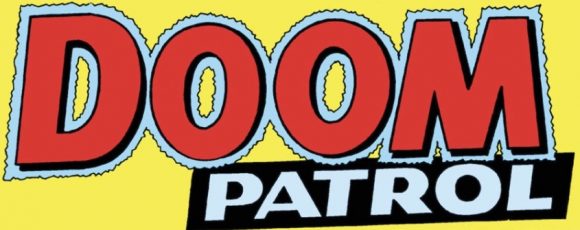
—
MORE
— JUSTICE LEAGUE OF AMERICA vs. FANTASTIC FOUR: 1960-66. Click here.
— The Complete COMIC BOOK DEATH MATCH Index. Click here.
—
13th Dimension columnist Fred Van Lente is a comics writer, historian and playwright.

September 23, 2021
I agree on the overall verdict! DOOM PATROL has that certain sonething that really sets it apart from other comic books of its time. Arnold & Bruno were firing on all cylinders! And don’t forget that Bob Haney laid claim to co-creating the DP! Not exactly sure if that claim was true or not?
September 24, 2021
Always luv’d the original Doom Patrol. I remember as a young reader being so devastated when they were killed off.
September 25, 2021
History is way more wild than fiction can come up with
September 25, 2021
Yes, the great mystery which will remain unsolved til time travel is invented or at least some way to view the past:
The Chief and Prof. X being wheelchair-bound: Rip off or incredible coincidence?
Well, the thing is this: Clearly possible but given that all of Marvel’s let’s inspirations up to that point — Atom/Ant-Man, Fly/Spider-Man, Hawkman/Angel — were different enough not be identical to the source material, it’s a little strange in the first instance. And then there’s this:
Just how closely was Stan Lee following DC comics? For that matter, why would, or how, would Doom Patrol even come on his radar? And unlike the possibly apocrvaphyl story of Goodman’s golf game in which someone from DC boasted to him about JLA sales, the timing here prevents any such thing. (Now that I think about it, if it was a rip off, I think maybe making Prof. X fully paralyzed would have a) avoided the obvious ripoff thing and b) would be kind of interesting.) Too, I can see the idea of teens needing a mentor but not one that could lead them on adventures as being a kind of interesting spin.
And then there’s let’s say the likelihood that Kirby had had no little input into the creation of the book. And one thing Kirby wouldn’t do is a blatant thing like a Chief/Prof. X ripoff, unless, of course, his editor told him to. A clue — how probative we cannot of course say — is that the original title, the Mutants — is what Kirby would be far more likely to come up with than Lee would. Kirby was plugged into science fiction and science news far more than Lee is known to have been.
So I lean towards coinky-dink.
Full disclosure: As a welp, I really enjoyed Lee’s scripting and I’m am still steadfast in my belief that his was, at the least one of the top two or three best editors in the 50s and 60s. So, you know, I can give a lot of credit to both Lee and Kirby. They just excelled in different areas which is to say why Kirby+Lee was one of those 1+1=3 things.